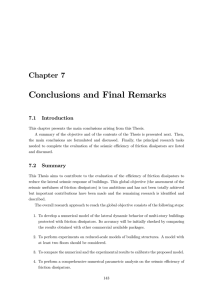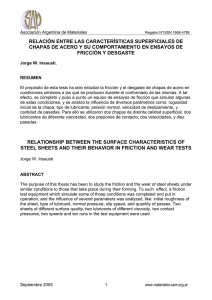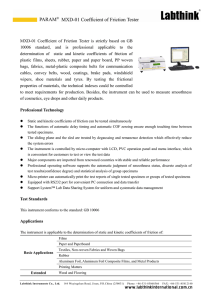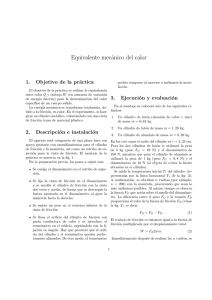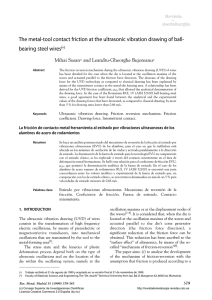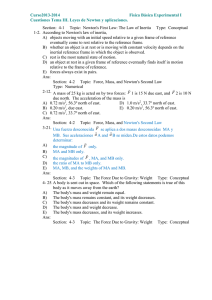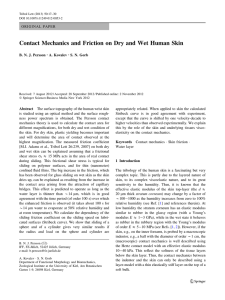State of the Art
Anuncio
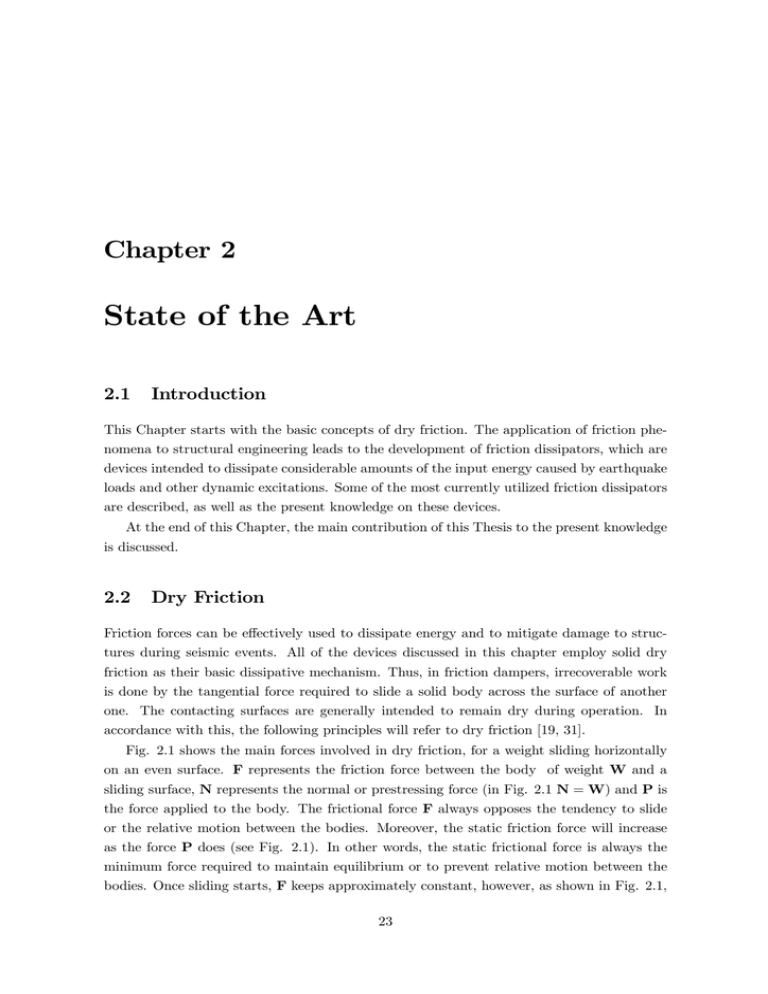
Chapter 2 State of the Art 2.1 Introduction This Chapter starts with the basic concepts of dry friction. The application of friction phenomena to structural engineering leads to the development of friction dissipators, which are devices intended to dissipate considerable amounts of the input energy caused by earthquake loads and other dynamic excitations. Some of the most currently utilized friction dissipators are described, as well as the present knowledge on these devices. At the end of this Chapter, the main contribution of this Thesis to the present knowledge is discussed. 2.2 Dry Friction Friction forces can be effectively used to dissipate energy and to mitigate damage to structures during seismic events. All of the devices discussed in this chapter employ solid dry friction as their basic dissipative mechanism. Thus, in friction dampers, irrecoverable work is done by the tangential force required to slide a solid body across the surface of another one. The contacting surfaces are generally intended to remain dry during operation. In accordance with this, the following principles will refer to dry friction [19, 31]. Fig. 2.1 shows the main forces involved in dry friction, for a weight sliding horizontally on an even surface. F represents the friction force between the body of weight W and a sliding surface, N represents the normal or prestressing force (in Fig. 2.1 N = W) and P is the force applied to the body. The frictional force F always opposes the tendency to slide or the relative motion between the bodies. Moreover, the static friction force will increase as the force P does (see Fig. 2.1). In other words, the static frictional force is always the minimum force required to maintain equilibrium or to prevent relative motion between the bodies. Once sliding starts, F keeps approximately constant, however, as shown in Fig. 2.1, 23 24 2. State of the Art P Friction force F W Equilibrium F a Motion N a 1 1 Theoretic line Experimental line b b Applied force P Relative velocity between the contact surfaces Figure 2.1 Friction force-applied force relationship the kinetic friction varies somewhat with the velocity, nevertheless, for the sake of simplicity, only the theoretic variation –horizontal line in Fig. 2.1– will be considered in this Thesis, as the relative velocity is not big enough to reach the non-flat zone. 2.2.1 Friction principles The scientific study of dry friction has a long history dating to the work of Da Vinci, Amontons and Coulomb [32, 33]. The basic theory relies on the following hypotheses, which were initially inferred from physical experiments involving planar sliding of rectilinear blocks [31]: 1. The maximum friction force that can be developed is independent of the apparent contact area, as long as the normal force keeps constant. 2. The maximum friction force that can be developed is proportional to the total normal force acting across the interface, provided that the pressure is uniformly distributed. 3. The maximum static friction force is greater than the kinetic friction force. 4. For the case of sliding with low relative velocity, the friction force is independent of that velocity. 2.2.2 Coulomb law of dry friction. Coefficient of friction The maximum static frictional force which can exist when motion impends between two surfaces is denoted by Fmax . The coefficient of static friction, µ, is defined as the ratio of the absolute value of the maximum static frictional force, Fmax , to the magnitude of the normal force, N , between the two surfaces. In mathematical form, 2.2. Dry Friction 25 Friction force F Maximum force = µN Sliding displacement Minimum force = -µN Figure 2.2 Rectangular hysteresis loops, typical of Coulomb dry friction µ= |Fmax | N (2.1) This equation expresses the Coulomb law of dry friction (see Appendix A). Since it is frequently observed that the coefficient of friction is somewhat higher when slippage is imminent than during sliding, separate static µs and kinetic µk coefficients are often introduced. In either case, the frictional force F acts tangentially within the interfacial plane in the direction opposing the motion or impeding it. The theoretical hysteresis loops for dry friction seen in Fig. 1.19 are now shown in Fig. 2.2. The maximum and minimum values of the friction force are, respectively, µN and −µN , according to Eq. (2.1). In some cases different values for both limits will be considered. In order to extend the theory to more general conditions, involving non-uniform distributions or non-planar surfaces, these basic assumptions are often abstracted to the infinitesimal limit. Thus, total forces are replaced by surface tractions, and the generalization of Eq. (2.1) becomes µ= |(τ t )max | σ (2.2) in terms of the maximum tangential traction (τ t )max and the normal traction σ [19]. This equation implies that τ t and σ are uniformly distributed through the surface. Eq. (2.2) is also useful for determining the nominal contact stresses that are often required for proper design. Note that an integration of Eq. (2.2) over a planar contact area renders Eq. (2.1). The concept of Coulomb friction, as described above, provides the theoretical basis for most of the research concerning friction dampers. However, it should be emphasized that frictional processes are seldom that simple. In practice the Coulomb theory is only approximately true. Furthermore, although the coefficient of friction µ, which appears in Eqs. (2.1) 26 2. State of the Art and (2.2), is often assumed to be constant for a given pair of contacting surfaces, this is not always the case. For example, the value of µ at any instant depends not only on the materials, but also on the present condition of the sliding surface. Since surfaces are often the site of numerous ongoing physical and chemical processes, the coefficient of friction associated with an interface may actually vary considerably over time. Many bimetallic interfaces are particularly susceptible to this behavior. The only safe policy for selecting a coefficient of friction for any given situation in a particular device is to make tests approximating as closely as possible the surface conditions, materials, pressures, and other factors which are to exist in the device. As a result of more recent experiments, the following additions and modifications to friction principles (Subsection 2.2.1) should be made: 1. For extremely low pressures and for pressures high enough to produce excessive deformation, the coefficient of static friction increases somewhat. 2. For extremely low relative velocities, the coefficient of kinetic friction increases and apparently becomes equal to the coefficient of static friction without any mathematical discontinuity. 3. For very high velocities, the coefficient of kinetic friction decreases appreciably. 4. Ordinary changes in temperature do not significantly affect the coefficient of friction. The friction principles and these last additions are based on experimental evidence and, hence, they are empirical in nature. Many efforts have been made to arrive at a theoretical explanation of the variation of frictional forces when relative motion impends or already exists. None of these efforts has been entirely successful, and at present the principles stated above are assumed to be valid within the limits of accuracy of the measurements [34, 35] The friction laws for lubricated surfaces are different from those for dry surfaces. For wet surfaces the frictional force depends primarily on the lubricant instead of the magnitude of the normal pressure and on the type of material and rugosity of the contacting bodies. 2.2.3 True contact surfaces In the following, some key aspects of the most contemporary approach related to the friction phenomena are considered. In particular, the modern theory of solid dry friction focuses on identification of the true contact area, the mechanisms involved in interfacial bonding, and the localized inelastic deformation that occurs in the contact region [19]. On detailed examination, it is possible to find out that both natural and engineered surfaces are not smooth at the microscopic level, but rather they contain irregularities, often categorized as waviness and roughness. These irregularities are typically present over a wide 2.2. Dry Friction 27 (a) Clean metallic surfaces (b) Metallic surfaces with oxide films and debris particles Figure 2.3 Contact surfaces range of scales. As a result of this initial topography and the deformational characteristics of the materials, true contact occurs only through the interaction of surface asperities, as depicted in Fig. 2.3a. The sketch suggests that the true contact area between two mating surfaces differs substantially from the apparent contact area. Researchers have found that a variety of topographical models involving conical, pyramidal, and hemispherical asperities, undergoing elastic or plastic deformation, produce true contact areas which are roughly proportional to the normal force. This, of course, is in general agreement with Coulomb theory. In any case, it becomes clear that any detailed investigation of frictional behavior must account for the actual surface irregularities instead of the idealization of perfectly smooth objects [34]. When true contact does occur directly between metals, adhesive bonds form across the interface often producing coefficients of friction µ > 1. However, adhesion provides a significant contribution primarily for the contact of clean metals. Actually, the schematic presented in Fig. 2.3a shows this situation. For more typical engineering applications, surface films and debris particles may also be present at the interface as indicated in Fig. 2.3b. In particular, oxide layers readily form under atmospheric conditions. These layers generally prevent the development of adhesive bonds. However, their presence also complicates the investigation of frictional processes, since the mechanical characteristics of oxide films is not well understood [34, 35]. 28 2. State of the Art The final aspect of the modern theory concerns the local deformational processes that occur in the vicinity of the interface. These processes involve the elastic, elastoplastic, and possibly viscoplastic response of the asperities, surface films, debris particles, and substrata. This can be viewed as a continuum mechanics problem. However the geometry, as depicted in Fig. 2.3, is now quite complex. Thermal processes associated with inelastic dissipation are activated. Additionally, brittle or ductile failure of oxide films can significantly affect the frictional strength of the interface through the establishment of a direct metal-to-metal contact. It is obviously difficult to analyze all of these factors. In order to obtain a more tractable problem, both geometric and constitutive simplifications are usually introduced [35]. This modern mechanistic approach to solid friction has led to an improved qualitative understanding of the process, however a quantitative assessment of frictional response from first principles is not yet possible. More importantly, since there is still no theory for sliding friction comparable to the well-established theory of metal plasticity, there is a need for much more reliance on physical testing [34, 35]. Despite the uncertainties of the real behavior of dry surfaces when the contact with friction is involved, the well known Coulomb’s friction law of dry friction (see Eq. 2.1) will be used further to derive the equations of motion of structures equipped with friction dissipators. 2.3 2.3.1 Friction Dissipators (FD) Definition As seen in Chapter 1, basically, friction dampers (FD) are devices that dissipate or absorb energy by means of the friction forces developed into them [19]. Some of these devices are shown in Fig. 1.17 and will be described in detail next in this chapter. Most of these systems of friction generate rectangular hysteresis loops, characteristic of Coulomb’s law of dry friction as shown in Fig. 1.19 or Fig. 2.2 [27, 28, 29]. On the other hand, friction dissipators differ in their mechanical complexity and the materials used in the sliding surfaces [30]. 2.3.2 Advantages and disadvantages of friction dissipators Typically, these devices possess good characteristics of structural behavior. Some of their advantages are the following: 1. They have a high capacity of energy dissipation. Considering the perfectly plastic behavior of the hysteresis loops of a FD, as those shown in Fig. 2.2, the area under 2.3. Friction Dissipators (FD) 29 the curve friction force-sliding displacement will be always greater than the area under a elastic-perfectly plastic curve, for a given value of µN . 2. Their behavior is not affected seriously by the amplitude, the frequency contents or the number of cycles of the driving force [30]. 3. They have a controllable friction force (through the prestressing –normal– force). 4. Compared to devices based on yielding of metals, friction dissipators possess a great capability of absorbing energy. However, this feature fails when the sliding surfaces wear. 5. Frictions dissipators are not affected by fatigue effects. Friction dissipators exhibit some potentially relevant disadvantages: 1. The energy dissipated per cycle is only proportional to the maximum displacement (see Fig. 2.2) instead of the square of this displacement, as in the case of viscous damping (see Appendix B). This fact can be relevant for sudden pulses and for inputs stronger than those expected. Moreover, resonance peaks can not be properly cut (see Appendix B). 2. Due to the frequent and sudden changes in the sticking-sliding conditions, high frequencies can be introduced in the response. 3. Durability is also a controversial issue, mostly due to the high sensitivity of the coefficient of friction to the conditions in the sliding surfaces. On the other hand, the dynamic behavior of friction dissipators is highly non-linear, so their numerical simulation becomes very difficult. This situation has arisen some controversial issues, such as the possible introduction of high frequencies into the structural response, as well as the lack of studies of these devices when subjected to near-fault pulses [30]. Conversely to other types of dissipators, no design guidelines have been issued for friction dissipators. 2.3.3 Environmental effects During slippage, localized heating of the contacting materials will definitely occur as energy is dissipated along the interface. In some cases, these thermal effects may alter the frictional response by causing material softening or by promoting oxidation. However, for the type of sliding systems typically encountered in friction dampers, it is unlikely that system response will be sensitive to the relatively small variations in ambient temperature that can be anticipated at any site [34, 35]. 30 2. State of the Art Of more concern are physicochemical processes, often triggered by atmospheric moisture of contaminants, that may occur in the interfacial region. These processes may change the physical and chemical character of the surfaces, and consequently produce a significant impact on the frictional response [34, 35]. In more aggressive environments, corrosion may pose a problem. It is necessary to rely on physical testing to determine the extent or corrosion expected in a given situation and to find out its potential effect on the frictional characteristics of a sliding system. 2.4 Types of Friction Devices and Structural Implementations Since many millennia ago, solid friction has played an important role in the control of tectonic movement and earthquake generation [36]. On a much smaller scale, friction is also used in automotive brakes as a means to dissipate the kinetic energy of motion (i.e., to stop the vehicles). Based primarily upon an analogy to the automotive brake, Pall et al. [24] began the development of passive frictional dampers to improve the seismic response of structures. According to these researchers, the objective is to slow down the motion of buildings ’by braking rather than breaking’ [37]. In recent years, there has been some structural applications of friction dissipators aimed to provide an extra protection to new and retrofitted buildings. The following will describe most of the proposed types of dissipators, and their applications. 2.4.1 Limited slip bolted (LSB) joint The limited slip bolted (LSB) joint originated by Pall et al. [24] is shown in Fig. 2.4. It is originally intended for seismic control of large panel structures. The LSB design incorporates brake lining pads between steel plates in order to provide a regular force-displacement response. Pall et al. [24] began their development of friction dampers by conducting static and dynamic tests on a variety of simple sliding elements having different surface treatments. The goal was not necessarily to obtain maximum energy dissipation, but rather to identify a system that possesses a regular, predictable response. For these tests contact was maintained between the surfaces by prestressing high strength bolts. The resulting load-displacement response under monotonic loading is shown in Fig. 2.5, while Fig. 2.6 details some hysteretic behaviors under constant amplitude displacement-controlled cyclic loading. 2.4. Types of Friction Devices and Structural Implementations Figure 2.4 Detail of a limited slip bolted (LSB) joint [24] Figure 2.5 Load-displacement response of LSB joints [24] 31 32 2. State of the Art Figure 2.6 Hysteresis loops of LSB joints [24] 2.4. Types of Friction Devices and Structural Implementations compression tension 33 tension compression Figure 2.7 Installation of Pall dampers in conjunction with cross bracing [37] 2.4.2 Pall’s friction damper An alternative design of the LSB and its location in the intersection of the ’X’ bracing system, is shown in Fig. 2.7 [37]. It is called Pall’s friction device and consists of rigid diagonal bars with friction hinges at their intersection points connected together by means of horizontal and vertical elements. These union elements ensure than when the axial load acting along the braces is big enough to initiate the sliding on the tension diagonal, then the compression diagonal will slide an equal quantity in the opposite direction. Initially Pall and Marsh used a simple elastoplastic model to represent the behavior of this X-braced friction damper. However, Filiatrault and Cherry determined that this is only valid if the device slips during every cycle, and if the slippage is always sufficient to completely straighten any buckled braces. Filiatrault and Cherry proposed a more detailed macroscopic model for the device. A schematic representation is shown in Fig. 2.8. Each member of the bracing-damper system is represented by elements reflecting its individual axial and bending characteristics. Hence, the structural braces are assumed to yield in tension, but buckle elastically in compression. The device links are permitted to yield in both tension and compression, while the sliding brake pads are represented by a hysteretic model corresponding to the experimental results obtained by Pall et al. [24]. The experimental hysteresis loops of the diagonal pads for a harmonic loading are shown in Fig. 2.9 [28]. The Pall’s device shown in Fig. 2.10, is an updated version of the cross-braced devices described above. Some studies in an earthquake simulator have been carried out, and a design methodology has been developed for the structures with this type of friction dissipators [28, 38]. Pall’s friction devices have been installed at thirteen buildings; six retrofitted and seven new. Some applications of Pall’s friction devices are described next. The library of the Concordia University at Montreal, Canada, consists of two buildings 34 2. State of the Art Figure 2.8 Refined model of Pall’s damper for an X-braced friction damper [28] Friction force (kN) No. of cycles = 50 (lbs) Excitation frequency = 0.20 Hz (in) Displacement (mm) Figure 2.9 Hysteresis loops of Pall’s friction device [28] 2.4. Types of Friction Devices and Structural Implementations 35 Figure 2.10 Pall’s friction damper [5] of six and ten floors, respectively, interconnected by means of a gallery. An external view of the structure is shown in Fig 2.11. The application of friction dampers in this structure is discussed in [17]. A total of 143 dampers were used. Curiously, the architects chose to expose sixty of the dampers due to their aesthetic appearance. A typical example is shown in Fig. 2.12. A series of nonlinear tridimensional time analyses carried out with the DRAIN-TABS program were utilized to establish the optimal sliding load of the devices, which varies from 600 until 700 kN, depending on their location into the structure. Artificial seismic signals were generated with a wide range of frequency contents and a peak acceleration scaled to 0.18g to represent the motion of the soil that was expected at Montreal. Under this level of excitation, an estimate of the rate of equivalent damping for the structure is approximately of 50%. Additionally, for this library, the use of friction dampers got a net saving of 1.5% of the total cost of the building. The application of Pall’s dampers to the building of the headquarters of the Complex of the Canadian Space Agency near Montreal is described in [5]. An aerial view of the whole complex is shown in Fig. 2.13. The headquarters building is a three-story framed steel structure cladded with aluminum panels. Since the structure holds equipment and sensitive instrumentation, additional protection is required from the potentially damaging effects of earthquakes. Nonlinear tridimensional analyses have been carried out using the computer program DRAIN-TABS to determine the feasibility of using friction dampers. Input forces included seismic signals artificially generated and scaled to produce a peak acceleration of 0.18g. Comparison with braced and unbraced configurations indicated a better performance for the designs with frictions dampers. Based on these results, a total of 58 frictional devices were specified, each one with a sliding load of 500 kN. The bays of the frame with ’X’ bracing 36 2. State of the Art Figure 2.11 McConell’s library of the Concordia University at Montreal [17] Figure 2.12 Friction damper exposed on the gallery of the McConell’s library [5] 2.4. Types of Friction Devices and Structural Implementations Figure 2.13 Complex of the Canadian Space Agency [5] Figure 2.14 Ground floor of the Complex of the Canadian Space Agency [5] 37 38 2. State of the Art Inner wedge Friction pad Outer wedge Outer cylinder Cup spring Figure 2.15 Longitudinal section of the Sumitomo’s friction device [13] and friction dampers are uniformly distributed throughout the whole building, as shown in the plan of Fig. 2.14, which corresponds to the first floor. Many dampers were intentionally exposed because of aesthetics effects. 2.4.3 Sumitomo’s friction damper This friction device was designed and produced by Sumitomo Metal Industries, Ltd., Japan (see Fig. 2.15). The Sumitomo device is an evolution of a friction damper utilized for railways cars, and the frictional resistance is generated by copper alloy lining pads, with pieces of graphite inserted, sliding against the inner surface of a metallic barrel. These devices are installed right under the girders and are connected to a ’chevron’ bracing system (see Fig. 2.16) [13]. Typical hysteresis loops of the Sumitomo damper are shown in Fig. 2.17. It can be seen that these hysteresis loops are very similar to those typical of Coulomb’s law of friction (see Fig. 2.2). These dissipators have been used in two buildings at Japan [27]. The Sumitomo devices for these buildings were designed with the aim of reducing the structural response due to soil vibrations and small or moderate earthquakes. The response control under big earthquakes was not a consideration for the main design. Three projects at Japan, that involve Sumitomo friction dampers, are briefly described in [13]. The first one is the Sonic Office Building (a 31-story steel frame) in Omiya City, built in 1988. A total of 20 dampers with a sliding force of 22 kips were used on every floor, mainly to reduce the effect due to the ground vibration and small earthquakes. A similar motivation led to the use of 4 dampers with a sliding force of 22 kips per floor in the Asahi Beer Azumabashi building at Tokyo. This 22-story steel braced structure was finished in 1989. The third project involves the use of Sumitomo friction dampers as a component of a system of seismic isolation for a 6-story reinforced concrete structure at Tokyo. 2.4. Types of Friction Devices and Structural Implementations 39 Damper mounting beam W4X13 Guide plate W4X13 W6X8.5 2 ¼ x ¼ x 3/16 SHS W6X8.5 (a) Upper floor (2-9). Dampers staggered at alternate levels Damper mounting beam W6X8.5 W14X13 W14X13 Guide plate 2¼x¼x 3/16 SHS W8X31 (b) Bottom floor Figure 2.16 Sumitomo’s friction dampers installed in the model [13] 8 Damper fore (kips) 6 Level 1W 4 2 0 -2 -4 -6 -0.4 -0.3 -0.2 -0.1 0.0 0.1 0.2 0.3 0.4 Displacement (inches) Figure 2.17 Hysteresis loops of the Sumitomo’s friction damper [13] 40 2. State of the Art Cylinder wall Steel com pression w edges Spring Internal stop Bronze friction w edges (typ 6 pla ces) End cap Friction wedge detail T ension ga p Spherical rod end bearing Compression gap Figure 2.18 External and internal views of the energy dissipation restraint (EDR) [4] 2.4.4 Energy dissipating restraint (EDR) Fluor Daniel, Inc., has developed and tested other type of friction device, which is called energy dissipating restraint (EDR). The EDR was originally developed as a restrictive seismic device for the support of piping systems in nuclear plants. The mechanism of the EDR consists of sliding friction with a stop located at the end of the range of motion. A complete detail for this device can be seen in Fig. 2.18, and in Fig. 2.19 a structure equipped with these devices is shown [4, 25]. The friction surfaces in this device are bronze wedges sliding on a steel barrel. The EDR has capacities of self-centering, and the sliding force is proportional to the displacement. In the EDR, two types of behavior are combined: linear stiffness and friction. Different combinations in between are possible, leading to different hysteresis loops, as shown in Fig. 2.20. 2.4.5 Slotted bolted connections (SBC) A slotted-bolted connection (SBC) (see Fig. 2.21) is connection where the slots in the main connecting are parallel to the line of action of the load [3, 39]. placed under the nut. Upon tightening of the bolts, a wide concept that refers to a bolted plate, in which the bolts are seated, In addition a Belleville washer [14] is the main plate is compressed directly 2.4. Types of Friction Devices and Structural Implementations Strut (typ 6 places) Load cell EDR 1½” 6” ¾” threaded rod 32” EDR EDR Elevation Force (pounds) Figure 2.19 Frame with equipped with EDRs in each floor [4] Displacement (inches) Figure 2.20 Hysteresis loops of the EDR [4] 41 42 2. State of the Art ½” diam. A325 bolt, 3 ½” long Hardened flat washer 8-EH-112 solon compression washer under nut 1/8” thick brass plates Main plate Direct tension indicator (DTI) under head Outer plates 9/16” x 3 ½” long slot Figure 2.21 Detail of a slotted bolted connection (SBC) [39] between the brass insert plates. The holes in such plates and in the steel outer plates are of conventional size. When the tensile or compressive force applied to the connection exceeds the friction forces developed between the frictional surfaces, the main plate slides relatively with respect to the brass insert plates. This process is repeated with sliding in the opposite direction upon reversal of the direction of the friction force. Energy is dissipated by means of friction between the sliding surfaces. In Fig. 2.22 an example of a metallic structure equipped with this type of dampers is shown. The application of cyclic loads of magnitude bigger than the magnitude of the friction force renders hysteresis cycles approximately rectangular (see Fig. 2.23) [3, 39]. The SBCs can also be used in timber structures [40]. There are other types of friction dissipators that behave in a similar way to the SBCs. In Fig. 2.24 two of these devices are shown. Fig. 2.24a depicts the friction grip connection developed by Roik et al. [41] and Fig. 2.24b shows a friction-slip device developed by Giaccetti et al. [42]. The dissipators tested for this research work are also similar to the SBCs (see Chapter 5). 2.4. Types of Friction Devices and Structural Implementations 150 kips Rigid deck W12X190 SBC 26 feet W12X72 W12X190 42 feet Force (kips) Figure 2.22 Single-story frame with a SBC [39] Displacement (inches) Figure 2.23 Hysteresis loops of a SBC [39] 43 44 2. State of the Art (a) Friction grip connection (b) Friction-slip device Figure 2.24 Other FDs similar to the SBCs [41, 42] Frictio n N o . o f b u ild in g s e q u ip p e d d e v ice w ith F D s (C ity / C o u ntry ) D e v ic e t e stin g S c a le d -d ow n m o d e ls D e sig n (w ith F D s) te stin g m e th o d o lo g y Yes [2 4 ] Ye s [2 8 ] Yes [3 8 ] 3 (J ap a n ) ? Ye s [1 3 ] ? Ye s [4 ] Yes [4 ] 2 (C a lifo rn ia ) Yes [3 , 2 9 , 3 9 , 4 3 ] Ye s [4 4 , 4 5 ] 2 0 (C a n a d a ) L S B / Pa ll’s 1 (Wash in g ton ) 1 (C a lifo rn ia ) S u m ito m o ’s EDR S B C o r sim ila r O th e r Yes [4 6 ] Yes [4 7 ] Table 2.1 Comparison of existing friction dampers 2.4.6 Summary In Table 2.1 the more relevant aspects of the FDs studied above are indicated. In this way a quick comparison can be made. Some important aspects with friction devices are: durability and long term maintenance, potential to induce high frequencies while these devices develop the ’sticking-sliding’ behavior, and possible residual strains after strong earthquakes. The maintenance and protection against wearing is essential, even after decades of nonuse [27]. 2.5. Present Knowledge on Friction Dissipators 45 Figure 2.25 Assumed elasto-plastic behavior of a FD 2.5 2.5.1 Present Knowledge on Friction Dissipators Numerical simulation of friction dissipators The dynamic behavior of friction dissipators (FD) is closely related to the contact theory since there are friction forces generated by sliding surfaces. Basically, the numerical simulation of FDs is based on the rectangular relationship friction force-displacement (see Fig. 2.2). This numerical approach, however, is not easy to implement in a model of the building due to the sudden change of the friction force direction. For this reason, simpler approaches have been developed to simulate, approximately, the perfectly plastic shape of the hysteresis loops using another elastic-plastic hysteretic model like the one shown in Fig. 2.25, considering for the initial stiffness k0 any big value (trying to approach an ’ideal’ vertical branch). Some minor modifications can be made in the ideal Coulomb model to make it closer to the real behavior of friction dissipators: to distinguish between the static and the dynamic friction coefficients and to define different values of the sliding force µN at both ends of the free run (instead of using ±µN ). This last condition has been considered in the simulation of the experiments (see Chapter 5). Other models are based on plasticity theory, like the one considered in the ADINA program [48]. 2.5.2 Numerical simulation of buildings equipped with friction dissipators There are currently a certain number of numerical simulations of structures equipped with FDs [5, 25, 39]. In order to carry out the numerical simulation, some computer programs have been written specifically with this purpose [26, 39, 49] while others use commercial 46 2. State of the Art software packages such as DRAIN-2D [28, 37, 50, 51], DRAIN-TABS [5], SADSAP [52], SAP2000NL [53] or ADINA [48]. Basically, the existing models fall into one of these two categories: 1. Models where the dynamic behavior of the friction dissipators is described by the contact analysis theory. Usually the equations of motion are solved by using Lagrange multipliers or penalty methods (e.g., ADINA). This approach can be accurate but its costly in terms of computational effort. 2. Simpler models where elasto-plastic laws for the friction dissipators are implemented (see Fig. 2.25) in finite element models of the whole structure (DRAIN-2D, DRAINTABS, SADSAP, SAP2000NL). This approach might lack of accuracy. 2.5.3 Testing of FDs and buildings equipped with FDs As shown in Table 2.1, there are some laboratory tests carried out on some types of friction dissipators as well as on some scaled-models of building structures incorporating friction dissipators. Important conclusions can be obtained out of these tests, for example, the hysteresis loops of the FDs are very close to theoretical ones shown in Fig. 2.2 [3, 29, 39, 43] and the dynamic response is similar to the numerical one [4, 28]. 2.5.4 Codes Currently, in the United States there are three major regulation codes for the design of structures equipped with passive control devices as described in [54]. The first regulation is included in the Appendix of Chapter 13 of the provisions issued by the Federal Emergency Management Administration (FEMA) No. 368 [55]. The second regulation is issued by the Structural Engineers Association of Northern California (SEAONC). Finally, the Applied Technology Council (ATC) includes also design guidelines to incorporate passive devices to new and retrofitted structures. All these regulations classify broadly the dissipators in two groups: velocity dependent (rate dependent) and displacement dependent (rate independent). The first category corresponds to viscous and viscoelastic dampers while the second corresponds to devices based on yielding of metals. It is unclear whether the recommendations issued for these devices can be extended to friction dissipators. Obviously, there is a lack of design codes, mainly regarding the use of friction dissipators. The need for research in this subject is evident. 2.5. Present Knowledge on Friction Dissipators 2.5.5 47 Open questions Despite a number of numerical and experimental studies dealing with the dynamic behavior of structures equipped with friction dissipators exists, due to the non-linear nature of their behavior, there are still relevant uncertainties regarding the seismic efficiency and proper design of these devices. Most of these questions are described in the following subsections. 2.5.5.1 Design criteria As said before, the design of friction dissipators for seismic protection of buildings is not quite standardized. There is a certain lack of code guidelines for an adequate design of FD. Despite this lack of regulations, some researchers have established some design parameters, based on the optimization of the dynamic behavior of structures equipped with FDs [38, 46, 47, 54]. Another situation has to do with the number of dissipators: some authors recommend to install the FDs in all floors [52] while others suggest to use less devices [56]. Also, some authors consider the variations of the parameters of the dissipators (mostly, the sliding forces) along the height of the building [46, 50] while others say that all the devices should have the same sliding force [52]. Further research is required to clarify these issues. 2.5.5.2 High frequencies When designing FDs, it is important to minimize the stick-slide phenomenon in order to avoid the introduction of high frequencies into the structure [30]. Further research is required to clarify this issue. 2.5.5.3 Sudden pulses According to the results of some researchers, the behavior of FDs under the action of seismic signals with harmonic excitations is better than for seismic inputs that come with sudden pulses (mostly due to near-fault phenomena) [4]. This might be generated by the lack of stiffness in the dissipators during sliding. Further research is required to clarify this issue. 2.5.5.4 Durability Due to the fact that the technology regarding the application of energy dissipation devices is relatively new, dissipators currently installed in structures have not been tested for a sufficient seismic loads, so the information regarding the durability of these devices is not yet available [30]. 48 2. State of the Art 2.5.5.5 Seismic efficiency The seismic efficiency of friction dissipators is still a controversial issue as it has not been completely demonstrated that the dynamic response (mostly in terms of interstory drifts) of protected frames (i.e., structures incorporating friction devices in the bracing system) is smaller than the one of the corresponding bare frames (frames without bracing) and braced frames (frames with rigid connections between the main frame and the bracing instead of dissipators). Some authors pay more attention to the dissipated energy but this is not the most relevant index as the input energy can be different as the properties of the dissipators change (see Chapter 6). It is required to perform parametric studies in order to understand better how some parameters affect the structural behavior. Further research is required to clarify this issue as no full study about the ability of friction dissipators to reduce the seismic response of buildings has been published. 2.5.5.6 Numerical simulation As said before, there are a number of papers that present numerical studies regarding the dynamic behavior of structures equipped with friction dissipators. Basically, the considered models belong to one of the two following cathegories: • Models based on contact analysis theory. This approach can be accurate but is costly in terms of computational effort. • Simpler models based on elasto-plastic laws. This approach might lack of accuracy. The need for models that combine the advantages of both groups but skipping their disadvantages is obvious. The reliability and accuracy of these models has to be soundly established. 2.6 Contribution of this Thesis to the Present Knowledge As discussed in the prior section, there are still some important open issues related to the seismic efficiency of structures equipped with friction dissipators. The main objective of this work is to clarify some of these uncertainties. To reach this goal, a numerical procedure will be developed (Chapters 3 and 4) and a computer program called ALMA will be written in Fortran code (Chapter 4). The results obtained out of this procedure will be compared to those obtained with the commercial program ADINA (Chapters 3 and 4) and to those obtained with ad-hoc experimental tests (Chapter 5). Also a methodology for performing a parametric study will be proposed (Chapter 6). This methodology will be mostly intended to determine the optimal sliding load of FDs installed in building structures.
